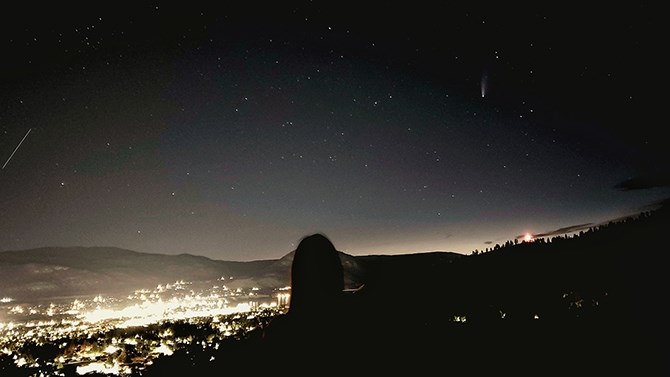
Calling it "stunning and something I would not forget," photographer Emily Wigley is in silhouette as she took this photo of comet Neowise above Penticton from a location on Carmi Road last night. In addition to Neowise, there are meteor showers and bright planets to see in the Thompson - Okanagan skies this week.
Image Credit: SUBMITTED / Emily Wigley
July 21, 2020 - 6:30 AM
This week’s night sky has comets, meteors and planets lining up for night sky viewing in the Thompson-Okanagan.
From Sunday, June 19 through the rest of this week, five planets will be visible in the night sky with the naked eye.
Forbes.com says Mercury and Venus will be most visible in the morning sky while Mars, Jupiter and Saturn will be most visible in the early evening darkness.
Mercury can be seen rising in the northeast around 45 minutes before sunrise, looking like a small, red dot.
Venus is very bright and easy to see, shining in the east.
In the evening darkness, Jupiter can be found in the western sky, easily seen as it should be very bright.
Saturn should be visible just above Jupiter in the western sky.
Mars can be seen higher above the southwestern horizon.
Viewers may need binoculars to see Mercury but the other four planets should be easily visible to the naked eye.
Adler Planetarium public observing director Michelle Nichols says this chance to see five planets in the same night sky is a once-in-20-year event.
The comet Neowise also continues to be visible in the post-sunset evening sky.
Penticton hobby photographer Emily Wigley drove up Carmi Road last night to photograph the comet above Penticton. She said it was dim and took some time to find in the night sky, but eventually located it southeast of the Big Dipper.
"After hearing stories and photos of Neowise, I had the urge to go out and photograph it, even though I don't usually go out at night to take photos," she says.
This week it is best seen after the sun sets. It should be visible for the rest of the month, but after that, you’ll have to wait about 6,800 years for it to come around again.
Also in view in the heavens above is the Delta Aquariids meteor shower, which is visible from July 12 to Aug. 23.
The Delta Aquariids are expected to peak in the early hours of Wednesday, July 29, offering views of shooting stars, about 20 per hour, in the region of the constellation of Aquarius. Best time to look is about an hour or two before dawn.
Environment Canada says viewing the region's night skies should be cloud-free every night except Wednesday, with night time temperatures in the mid-teens.
To contact a reporter for this story, email Steve Arstad or call 250-488-3065 or email the editor. You can also submit photos, videos or news tips to tips@infonews.ca and be entered to win a monthly prize draw.
We welcome your comments and opinions on our stories but play nice. We won't censor or delete comments unless they contain off-topic statements or links, unnecessary vulgarity, false facts, spam or obviously fake profiles. If you have any concerns about what you see in comments, email the editor in the link above.
News from © iNFOnews, 2020